U.S. Treasuries Go Parabolic as Hedge Funds Exit From Stocks
Stock-Markets / Financial Markets 2010 Aug 21, 2010 - 05:47 AM GMT Jobless Claims in U.S. Rose to Highest Since November - Claims for U.S. jobless benefits jumped to the highest level since November and Philadelphia-area manufacturing shrank for the first time in a year, indicating the economy may be slowing faster than forecast.
Jobless Claims in U.S. Rose to Highest Since November - Claims for U.S. jobless benefits jumped to the highest level since November and Philadelphia-area manufacturing shrank for the first time in a year, indicating the economy may be slowing faster than forecast.
The number of unemployment claims unexpectedly shot up by 12,000 to 500,000 in the week ended Aug. 14, Labor Department figures showed today in Washington. The Federal Reserve Bank of Philadelphia’s general economic index turned negative in August, signaling contraction.
“There’s a red flag being waved right now that says ‘Danger,’” said Mark Vitner, a senior economist at Wells Fargo Securities LLC in Charlotte, North Carolina. “Growth is going to slow in the second half and we might face something a little more ominous than that.”
Goldman Explains Why The Job Loss Trend Is A Deterioration Not A Distortion
(ZeroHedge) Goldman's Andrew Tilton has nothing good for the factless pumpers of the recoveryless recovery: "The timing of the rise in new claims fits with the surge in extended benefit recipients (although as already noted the auto distortion probably had its largest downward impact on claims in that same week). This raises the question of whether some of the people who lost benefits due to funding problems reapplied via new claims, when in fact they simply should have gone back on the benefit rolls without the need to file a new claim.
This is a scary possibility, as it means that those on the verge of exhuasting their 99 weeks of maximum benefits may have found an unexpected loophole to make the length of the "welfare state" support up to 198 weeks (or double the existing max).
Hedge fund managers join private investors for the exit.
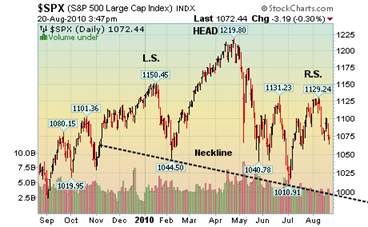 --Investment Company Institute reported that domestic equity (stock) funds reported their 1th sequential outflow last week as $2.073 billion was withdrawn from domestic stock mutual funds. Retail investors pulled out $13.1 billion during July’s ramp, followed by $4.1 billion so far in August. Even hedge fund managers are feeling the stress.
--Investment Company Institute reported that domestic equity (stock) funds reported their 1th sequential outflow last week as $2.073 billion was withdrawn from domestic stock mutual funds. Retail investors pulled out $13.1 billion during July’s ramp, followed by $4.1 billion so far in August. Even hedge fund managers are feeling the stress.
Treasury bonds go parabolic.
 -- Treasury 10-year notes headed for a fourth weekly gain, the longest run since February, on signs global economic growth is slowing, increasing the refuge appeal of the world’s most easily traded securities.
-- Treasury 10-year notes headed for a fourth weekly gain, the longest run since February, on signs global economic growth is slowing, increasing the refuge appeal of the world’s most easily traded securities.
Traders are bidding up treasury bonds and notes as a bid to find a safe haven from the decline in stocks. Unfortunately, the rally may be overdone.
Gold extended its rally until today.
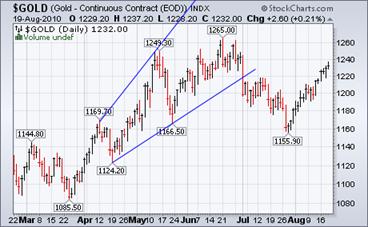 --Recession fears may have put a limit on the gold rally today. In addition, the general liquidation of stocks may have started to spread to the precious metals, as well. Through yesterday, gold rallied 12.75% since the beginning of the year. However, it has been on a secular uptrend since June, 2001. Nine years is a long time in any bull market. It may need a rest.
--Recession fears may have put a limit on the gold rally today. In addition, the general liquidation of stocks may have started to spread to the precious metals, as well. Through yesterday, gold rallied 12.75% since the beginning of the year. However, it has been on a secular uptrend since June, 2001. Nine years is a long time in any bull market. It may need a rest.
The Nikkei may be heading down again.
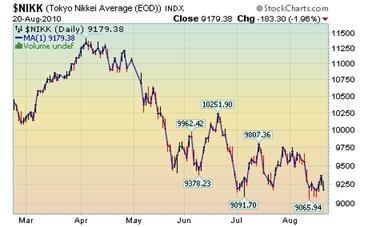 -- Japanese stocks dropped, sending benchmark gauges to their second weekly decline, after worse-than-expected jobs and manufacturing data in the U.S. and on a report Sharp Corp. will cut output of liquid crystal displays. The Nikkei 225 fell 2 percent to 9,179.38 at the 3 p.m. close in Tokyo. For the week, the Nikkei retreated 0.8 percent, while the Topix slipped 0.2 percent.
-- Japanese stocks dropped, sending benchmark gauges to their second weekly decline, after worse-than-expected jobs and manufacturing data in the U.S. and on a report Sharp Corp. will cut output of liquid crystal displays. The Nikkei 225 fell 2 percent to 9,179.38 at the 3 p.m. close in Tokyo. For the week, the Nikkei retreated 0.8 percent, while the Topix slipped 0.2 percent.
The Shanghai index may test its uptrend soon.
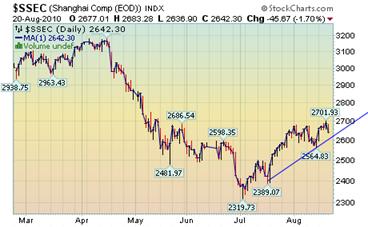 -- China's shares fell Friday as Beijing's latest move to tighten its grip on rising real estate prices pressured property developers, while concerns over measures aimed at clamping down on local government financing weighed on the banking sector.
The benchmark Shanghai Composite Index, which tracks both A and B shares, ended down 1.7%, or 45.67 points, at 2642.31 after closing at a more than three-month high Thursday. The index was up 1.4% on the week.
-- China's shares fell Friday as Beijing's latest move to tighten its grip on rising real estate prices pressured property developers, while concerns over measures aimed at clamping down on local government financing weighed on the banking sector.
The benchmark Shanghai Composite Index, which tracks both A and B shares, ended down 1.7%, or 45.67 points, at 2642.31 after closing at a more than three-month high Thursday. The index was up 1.4% on the week.
The dollar prepares for its largest move yet.
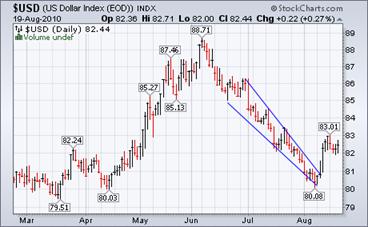 --The dollar emerged from a wedge formation in early August and may be preparing for a large spike higher. The wedge drawn on the chart is called an ending diagonal, which implies not only a complete retracement, but new highs as well.
--The dollar emerged from a wedge formation in early August and may be preparing for a large spike higher. The wedge drawn on the chart is called an ending diagonal, which implies not only a complete retracement, but new highs as well.
From a cyclical view, the dollar made an important Seasonal low in August. This kind of low may not be seen again until April, 2011.
Bill Black: U.S. Using "Really Stupid Strategy" to Hide Bank Losses
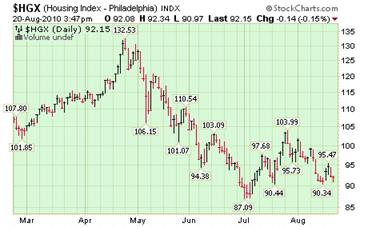 --The situation is likely even worse than the FDIC portrays, says William Black Associate Professor of Economics and Law at the University of Missouri-Kansas City.
--The situation is likely even worse than the FDIC portrays, says William Black Associate Professor of Economics and Law at the University of Missouri-Kansas City.
“The FDIC is sitting there knowing that it has both the residential disaster and the commercial real estate disaster [and] knowing it doesn’t have remotely enough funds to pay for it,” he says.
Gasoline prices are at a 6-month low.
 --The Energy Information Agency weekly report observes, “The U.S. average retail price for regular gasoline decreased almost four cents from last week to $2.75 per gallon but was $0.11 per gallon higher than this time last year.
--The Energy Information Agency weekly report observes, “The U.S. average retail price for regular gasoline decreased almost four cents from last week to $2.75 per gallon but was $0.11 per gallon higher than this time last year.
The Midwest registered the largest price decrease, seven and a half cents, to settle at $2.68 per gallon.”
High domestic production keeps natural gas prices down.
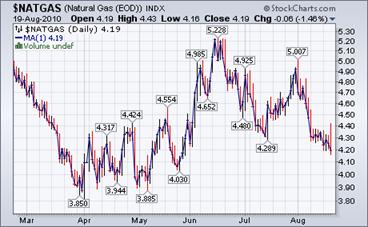 -- The U.S. Energy Information Administration reports, “Price declines in the East were mostly moderate during the report week, while changes in the West were more significant. On Wednesday, August 18, the Henry Hub natural gas spot price averaged $4.35 per MMBtu, which was $0.03 less than the average price the previous Wednesday. With the exception of just two trading locations, all markets experienced price declines as temperatures moderated on both coasts and domestic production remained strong.”
-- The U.S. Energy Information Administration reports, “Price declines in the East were mostly moderate during the report week, while changes in the West were more significant. On Wednesday, August 18, the Henry Hub natural gas spot price averaged $4.35 per MMBtu, which was $0.03 less than the average price the previous Wednesday. With the exception of just two trading locations, all markets experienced price declines as temperatures moderated on both coasts and domestic production remained strong.”
Dr. Keynes Killed the Patient
American consumers are trying their best to deleverage. In terms of the story, the patient is actually trying to lose weight. But the government is blocking deleveraging and trying to boost consumption. They are forcing food down the patient's throat. According to the Flow of Funds Report, households reduced debt at a 2.4% annualized rate ($330 billion) during Q1 of 2010. Meanwhile, the federal government was piling on debt at an 18.5% annual rate ($1.44 trillion). Since every dollar of government debt is a promise to tax the private sector in the future with interest, this public spending spree effectively negated the Herculean efforts of the private sector to return to a sustainable path.
That's where the arrogance of Washington is really apparent. Scores of millions of American consumers have made the decision that reducing their debt burden is in their best interests right now. But a few hundred individuals in government believe they know better than the collective wisdom of the entire free market. By leveraging up the public sector, they have used their power to confiscate our savings. In short, they are forbidding us from following the common sense path to fiscal health.
Social Security, and the Chilean AFP System
(ZeroHedge) There’s been a lot of talk, lately, from the American political classes, about “reforming” Social Security. About the need for “tough choices.”
This isn’t surprising. Social Security is a demographic and financial time-bomb. With something like 60 million Baby Boomers about to begin retiring, the so-called “Social Security lock-box” is going to take quite the beating—especially considering that that famed “lock-box” is stuffed not with money but with IOU’s, placed there by the Treasury as it used the Social Security money to finance deficit spending.
People aren’t blind or stupid, even though they do seem to act that way most of the time. They know that Social Security can’t possibly afford to pay off what it owes the Baby Boom generation. Politicians of both parties are making rumbling noises, essentially in two directions: Cutting benefits, and finding an “alternative system”.
Record Number Of Americans Using Retirement Funds As Source Of Immediate Cash
According to the Fidelity study, "Among the 11 million workers whose 401(k) plans are run by Fidelity, 11 percent took out a loan from their plan during the 12 months ended June 30, the company said, up from 9 percent at the same point a year earlier. By the end of the second quarter, plan participants with loans outstanding against their 401(k) accounts had reached 22 percent versus 20 percent a year earlier."
Traders alert: The Practical Investor is currently offering the daily Inner Circle Newsletter to new subscribers. Contact us at tpi@thepracticalinvestor.com for a free sample newsletter and subscription information.
Our Investment Advisor Registration is on the Web
We are in the process of updating our website at www.thepracticalinvestor.com to have more information on our services. Log on and click on Advisor Registration to get more details.
If you are a client or wish to become one, please make an appointment to discuss our investment strategies by calling Connie or Tony at (517) 699-1554, ext 10 or 11. Or e-mail us at tpi@thepracticalinvestor.com .
Anthony M. Cherniawski, President and CIO http://www.thepracticalinvestor.com
As a State Registered Investment Advisor, The Practical Investor (TPI) manages private client investment portfolios using a proprietary investment strategy created by Chief Investment Officer Tony Cherniawski. Throughout 2000-01, when many investors felt the pain of double digit market losses, TPI successfully navigated the choppy investment waters, creating a profit for our private investment clients. With a focus on preserving assets and capitalizing on opportunities, TPI clients benefited greatly from the TPI strategies, allowing them to stay on track with their life goals
Disclaimer: The content in this article is written for educational and informational purposes only. There is no offer or recommendation to buy or sell any security and no information contained here should be interpreted or construed as investment advice. Do you own due diligence as the information in this article is the opinion of Anthony M. Cherniawski and subject to change without notice.
Anthony M. Cherniawski Archive |
© 2005-2022 http://www.MarketOracle.co.uk - The Market Oracle is a FREE Daily Financial Markets Analysis & Forecasting online publication.



